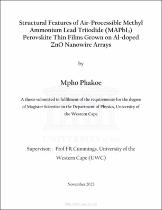| dc.contributor.advisor | Cummings, Franscious | |
| dc.contributor.author | Phakoe, Mpho | |
| dc.date.accessioned | 2023-11-30T09:49:11Z | |
| dc.date.available | 2023-11-30T09:49:11Z | |
| dc.date.issued | 2023 | |
| dc.identifier.uri | http://hdl.handle.net/11394/10592 | |
| dc.description | >Magister Scientiae - MSc | en_US |
| dc.description.abstract | The performance of air stable, mixed halide (MAPbI3-xClx) perovskite based solar cells is highly dependent on the quality and stability of the perovskite thin film, which in turn, is dependent on the substrate on which it is deposited. ZnO presents excellent optoelectronic properties such as high electron mobility and diffusion length, direct band gap with high exciton binding energy. An array of ZnO nanowires (NWs) grown vertically on a conducting substrate, benefits from a large surface area, direct electron transport pathway and reduced recombination rate of carriers when used in a solar cell. These arrays of ZnO NWs may be synthesised by a wide range of methods, with the chemical bath deposition (CBD) method considered to be the most simple and cost-effective. | en_US |
| dc.language.iso | en | en_US |
| dc.publisher | University of the Western Cape | en_US |
| dc.subject | Methyl Ammonium Lead Triiodide | en_US |
| dc.subject | Perovskite | en_US |
| dc.subject | ZnO Nanowire Arrays | en_US |
| dc.subject | Photovoltaics | en_US |
| dc.subject | Electron Microscopy | en_US |
| dc.title | Structural features of air-processible methyl ammonium lead triiodide (MAPbI3) perovskite thin films grown on Al-doped ZnO Nanowire Arrays | en_US |
| dc.rights.holder | University of the Western Cape | en_US |

